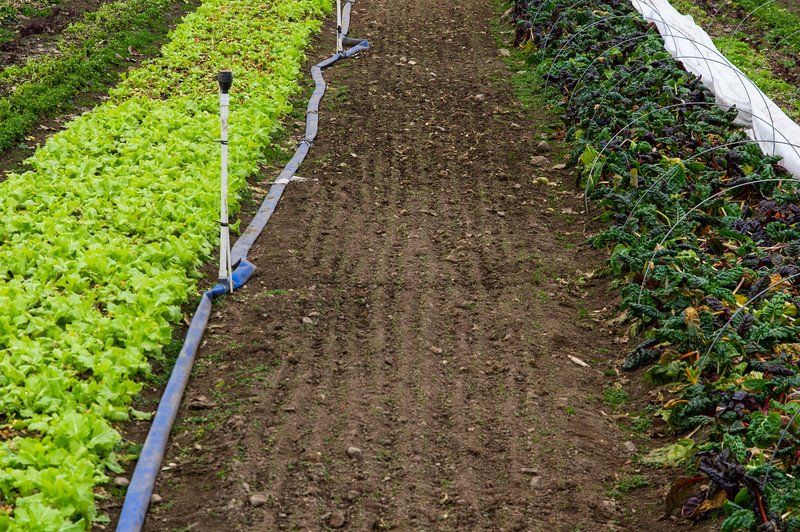3rd Week of the Winter/Spring CSA season: Week of March 2nd
The Chocolate Factory: home of the spinach and kale… If you are new to our CSA, all the high tunnels are named with inspiration from Roald Dahl books , photo by Adam Ford
This Week’s Availability
This week we will have red beets, white daikon radishes, purple daikon radishes, watermelon radishes, orange carrots (Juniper Hill), rainbow carrots (Juniper Hill), shallots, red and yellow onions (Juniper Hill), garlic, green cabbage, mini red cabbage, red and yellow potatoes (Atlas Farm), fingerling potatoes (Clearfield Farm), sweet potatoes (Junpier Hill), spinach, mesclun mix, baby kale mix, baby rainbow chard, and frozen heirloom/beefsteak tomatoes.
There are no more limits on greens this week!
The frozen heirloom/beefsteak tomato bags are “2 items worth:” and are delicious for stewing.
Did you know that sweet potatoes store best at room temperature? Being kept in cold storage for too long speeds up their decomposition. Keep them on your counter until you use them.
Ordering closes at noon on Tuesdays for Wednesday bags, and at noon on Thursdays for Friday bags.
You do not need to fill out the form if you plan to come to the barn on Wednesdays or Thursdays to pick out your items yourself.
koji is a mild green leaf in the mesclun mix, photo by Adam Ford
salad greens germinating, photo by Adam Ford
fun colors on a Molly painting somewhere on the farm, photo by Adam Ford
Uncovered edge of the strawberries, looking alive and well. 3 more months until strawberry season!! photo by Adam Ford
Farm News
We’re excited that, with the longer daylengths and spells of warm weather, the greens have begun to pick up their growth. This week we get to add some new greens to the CSA availability: baby kale mix and baby rainbow chard are new this week, in addition to spinach and mesclun mix. And even better, there will be no limits on the number of greens in your share: if you are a small share, for example, you can take all six of your items as greens if you like. For those of you, like us, who really enjoy the baby lettuce our farm grows, we’ll have to wait a few more weeks for the overwintered lettuce plants to register the coming of spring. They unfortunately have the quality of being the slowest of the greens to resume growth as the winter recedes.
This past week we’ve continued some seeding: our first tomato seeds have been planted, from which we’ll grow about 600 tomato plants for the first round to be planted in our high tunnels. These seeds grow in trays in an insulated multi-purpose room in the basement of our barn. In the fall, that space is used for cold storage of vegetables: potatoes, carrots, radishes, etc. Shortly after the new year, when that cooler has been fairly well emptied of vegetables, we move the remaining vegetables into the basement of the barn, where cold but not freezing temperatures are maintained by a thermostatically controlled exhaust fan that pulls in cold air from outside. In early February, we set up grow lights in the insulated room, where we seed trays of greens that will be transplanted into the tunnels in early March. This allows us to get a limited number of trays started very early in the season, without needing to use a huge amount of fuel to heat our seed-starting greenhouse. It’s a little tricky to grow seedlings this early in the year, but it allows us to have a more abundant harvest of vegetables in the transition season of April and May, and it allows us to harvest tomatoes a few weeks earlier in the summer, when everyone is excited for the first fresh tomatoes!
Otherwise, this time of the year, we take what the weather gives us: computer work (or maybe even a ski!) on the cold cloudy days and some summer-prep projects when the weather is beautiful. This coming week with cold temperatures we’ll skid the final round of logs from our forest to be milled into the rafters for the new building. Before long we’ll set our sights on doing some deep-cleaning of our work spaces, making some repairs in our seedling greenhouse, and setting it up to grow thousands of trays of plants.
-ESF Team: Ryan, Kara, Molly, Katie, Taylor, and, Cindy
drainage ditch flowing well during the melting, photo by Adam Ford
covered slab for the new building after the snow melted, photo by Adam Ford
my least favorite style of harvest knife that cuts my fingers more than greens (so I just don’t use this one), photo by Adam Ford
a melted ghost of a Napa cabbage left in the field, uncovered when the snow melted, photo by Adam Ford









